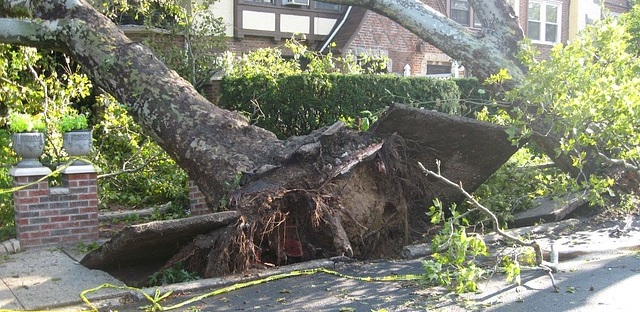A Comprehensive Approach
The arrival of autumn in East Anglia brings with it picturesque landscapes as the trees shed their leaves in preparation for winter. However, this beautiful season is also marked by a rise in storm activity, leading to potential damage to trees and, by extension, property and public safety concerns. With powerful winds, heavy rains, saturated soils and occasional thunderstorms, the risk of tree damage during this time becomes a significant issue for both rural and urban areas in the region. Dealing with such tree damage requires careful planning and swift action to prevent accidents and safeguard homes and protect property and public spaces.

Autumn storms in East Anglia can cause significant tree damage, leading to safety concerns. To minimize risks, it is important to address the situation promptly. Once the storm weather has passed. Start by assessing the trees around your property or local area for any signs of instability, such as broken branches on the ground or within the tree, leaning trunks, or uprooted roots. If you notice any immediate dangers, contact local authorities or a professional tree surgeon to handle the removal or trimming of hazardous trees.
Regular maintenance is key to preventing future damage. Safety surveys and pruning trees before storm season can help reduce the chances of branches falling and causing harm. Additionally, keep an eye on trees that are particularly old or located near buildings, roads, or power lines, as they may require special attention.
Staying informed about weather warnings and taking proactive measures, such as removing weak trees or branches before a storm hits, can reduce the likelihood of damage. During and after a storm, avoid standing near trees, and always be cautious of potential falling branches or debris.

Understanding the Impact of Autumn Storms on Trees
Autumn storms can be especially harsh on trees due to several factors. As the season progresses, trees naturally shed their leaves, making them more vulnerable to the wind’s force. The combination of wind and rain can weaken branches, causing them to break off or, in more severe cases, lead to entire trees being uprooted. East Anglia, with its often flat landscape, can experience particularly strong winds that cause widespread damage.
Deciduous trees, common in East Anglia, are usually better adapted to shedding their leaves in autumn, which reduces the surface area and limits wind resistance. However, large trees that have not been pruned or properly maintained may suffer significant damage if subjected to prolonged periods of high winds. In extreme cases, trees can be uprooted or suffer from root failure, particularly in areas where soil drainage is poor due to heavy rainfall.

Immediate Safety Concerns
After a storm, the first concern should always be public safety. Falling branches, toppled trees, and debris on roads or properties present serious hazards. It is crucial to assess the immediate environment for signs of tree damage, especially near homes, roads, or public pathways. A common mistake is to approach or attempt to clear fallen branches without professional help. This can lead to injuries from unstable or partially damaged trees, as branches can fall unpredictably.
If a tree or large branch is found leaning or at risk of falling, it is essential to stay clear of the area and alert the local council or emergency services if the tree poses an immediate danger. In East Anglia, local authorities often dispatch teams to handle fallen trees on public land, but homeowners are responsible for trees on their private property. Knowing whom to call in the aftermath of a storm can significantly reduce the time spent resolving dangerous situations.

Long-Term Prevention and Tree Maintenance
While it is impossible to prevent storms, proper tree care and maintenance can mitigate the risks they pose. One of the best long-term strategies for reducing storm damage is regular tree pruning. Pruning helps remove dead or weakened branches, which are more likely to break during high winds. A well-pruned tree will have a more balanced structure, allowing wind to pass through more easily without causing severe damage. Additionally, trees that are not too top-heavy are less likely to fall, as their root systems will not be overly strained during storms.
Regular inspections of trees, especially those near buildings or roads, are essential. Trees with signs of disease, decay, or pests should be treated or removed to prevent future damage. Signs to look for include cavities in the trunk, peeling bark, or fungal growth, all of which can indicate internal weakness. Even trees that appear healthy on the outside may be vulnerable if they are not regularly checked by a professional arborist.
In some cases, it may be necessary to remove trees that pose too great a risk. This can be a difficult decision, especially if the tree has been a longstanding feature of a garden or neighbourhood. However, in areas prone to strong autumn winds, the removal of a potentially dangerous tree can save significant costs and prevent accidents. An arborist can advise on whether a tree should be removed or if it can be salvaged through careful trimming.

Role of Professional Arborists
Engaging the services of a professional tree surgeon or arborist is one of the most effective ways to ensure trees are prepared for storm season and to address damage afterward. Arborists are trained to assess the health and stability of trees and to take the necessary steps to protect them from storm damage. They can recommend the best types of pruning and maintenance, and in the event of a fallen tree, they can safely remove the debris and assess whether other nearby trees are at risk.
Professional involvement is particularly important for large or mature trees. While smaller trees can often be pruned by homeowners, large trees require specialized equipment and knowledge to prune correctly and safely. Attempting to prune a large tree without professional help can not only damage the tree but also put the homeowner at risk of injury. Arborists also have the skills to evaluate root systems and soil conditions, which is essential in areas where heavy rains can lead to root failure.
In East Anglia, where storms can hit unexpectedly, it is wise to establish a relationship with a local tree service before an emergency arises. Having a professional assess your property and create a maintenance plan can help avoid costly and dangerous situations later. In addition, professionals can offer advice on which species of trees are best suited to withstand storm conditions, allowing homeowners to plant more resilient trees in the future.

Environmental and Ecological Considerations
Storm-damaged trees not only present immediate dangers but also have broader ecological impacts. Fallen trees and large branches can disrupt wildlife habitats, particularly for birds and small mammals that rely on trees for shelter. Therefore, when addressing tree damage, it is important to consider the local ecosystem. In some cases, leaving a fallen tree or part of a tree on the ground can actually benefit local wildlife, creating new habitats for insects, fungi, and small animals. Of course, this should only be done when the fallen tree poses no safety risks.
In East Anglia, many towns and rural areas have initiatives to replant trees in public spaces to maintain the region’s biodiversity. Replacing fallen trees with native species can help restore the balance of the local ecosystem while providing long-term benefits, such as reducing wind speed and stabilizing the soil during future storms. Homeowners can also contribute to these efforts by planting storm-resistant trees in their gardens and supporting local conservation efforts.

Planning for Future Storms
As climate change continues to affect weather patterns, the frequency and intensity of storms in East Anglia may increase. Preparing for future storms involves not only dealing with tree damage as it happens but also planning for long-term resilience. Communities can work together to ensure that public spaces are regularly inspected and maintained, and homeowners can do their part by taking care of the trees on their properties.
Regular tree surveys and reviewing the impacts of construction or adjacent tree removals should be part of the decision process when planning the way forward.
Being a new homeowner or about to purchase a property seek opinions and surveys to manage the risk.

The new National Tree safety Guidance Common sense risk management of trees: Full guidance 2024
provides good advice for tree owners.
In addition to tree maintenance, there are other strategies for storm preparedness. Installing windbreaks, such as hedges or fences, can help reduce wind damage to trees and other plants. Ensuring that gutters, drains, and other infrastructure are clear of leaves and debris before a storm can help prevent flooding, which in turn reduces the likelihood of tree root failure due to waterlogged soil.
The role of local councils and community organizations in storm preparedness should not be underestimated. In East Anglia, many communities already have plans in place for dealing with storms, including emergency response teams that handle tree damage and road blockages. By staying informed about local initiatives and weather warnings, residents can contribute to a safer and more resilient community.

Conclusion
Autumn storms are a natural part of life in East Anglia, but the damage they can cause to trees and the surrounding environment is not inevitable. Through a combination of regular tree maintenance, professional arborist services, and community cooperation, the risks posed by storms can be significantly reduced. Whether it is pruning trees before the storm season, removing dangerous trees, or planning for long-term resilience, there are many steps that homeowners and local authorities can take to protect both people and property from the effects of autumn storms.
By taking these measures, East Anglia can continue to enjoy the beauty of its trees and natural landscape while minimizing the dangers that come with seasonal storms. The key to success lies in early action, thoughtful planning, and a commitment to preserving both safety and the environment.









